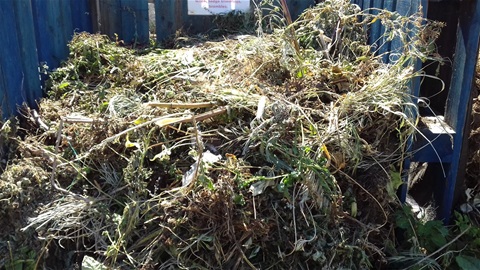Lack of greens in dry spells
This spring it has been very dry in the UK which presents an interesting situation when community composting on the allotment, a shortage of “Greens”.
Composting requires a balanced mix nitrogen rich “Greens” and carbon rich “Browns” and at home with materials available from the garden, kitchen and packaging this does not present a problem. However, on the allotment the situation may be more challenging.
Greens are usually green in colour, hence the name, or are from plants that were green at some point and include fresh weeds, leaves, and vegetables tops, plants that have bolted and fresh grass clippings, if available (many allotments no longer have grass paths).
Browns are usually brown in colour, or naturally turn brow. They are carbon-rich materials that help to add bulk to the material assisting air to filter through the bin. Brown materials include woody plant material and dried leaves, dried grass clippings, hay , straw and cardboard. Some Browns may have started life as greens but as they have aged or dried out, they lose nitrogen and turn brown at the same time. Green leaves will have had a high level of nitrogen when fresh, but as they dry and go brown(ish) the nitrogen levels drop.
As can be seen from the photos much of the material left in the Reception bin this week consists of dried grass, dried weeds, and plants. If the compost bin gets too dry the decomposing process will slow as the microbes will not be able to function effectively. As mention in the last blog there is a need to maintain the moisture level by watering the heap as fresh material is added.
But there is still a need to find and add Greens. Luckily, the answer can be found in the manure heap or chicken house.
In recent years, the use of manures in making compost has be criticized because of the perceived risks to health and concern that pathogens in the manure might infect the composter and contaminate the vegetables grown where the compost has been used. In fact, the risks are easily kept at an acceptable level and benefits of using matured cow manure far outweigh the risks particularly when there is a shortage of greens. Most allotments will have an arrangement with a local farmer to deliver cow manure and it is a good idea to keep a separate pile on the plot so that it matures. Chicken manure is good if birds are kept on the plot.
When using manure in a pallet bin where the organic material has dried out, I use woody browns as the base layer followed by the dried organic material, without trying to separate it into greens and browns. This is followed by a thin layer of manure. Each layer is patted down and ensure that it is level. The alternate garden waste and manure layers are continued until the bin is full. It is then topped off with a 1 – 2-inch layer of completed compost or garden soil.

Latest comments
Do you have any data on ' application ' of Aerated Vermi Compost Tea to Mangoes and benneficial outcomes .
Very informative site. Having been away for 5 weeks and returning to evidence of rats under and around the compost bin, I can testify to lack of human activity allowing the rats to get comfortable.
can i use dog manure in compost and mulching leaves?
What is the C and N ratio for coffee chaff?